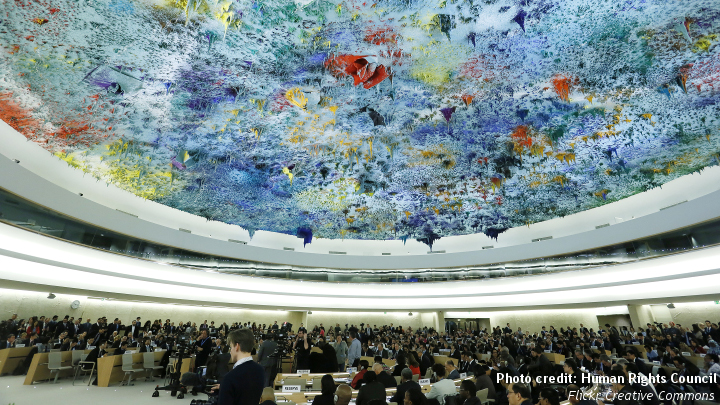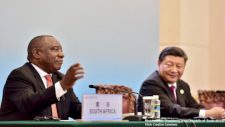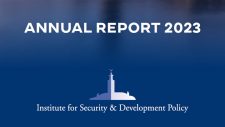Human Rights in China

ISDP
Summary
- The People’s Republic of China (PRC) has chosen to promote collective rights such as the right to development.
- The PRC can improve human rights conditions further. However, due to its massive population and economy any reforms have to be gradual.
- Ideological differences often put China at odds with commentators from abroad whose perspective differs with policymakers.
- This ISDP Backgrounder presents the historical context to human rights in China as well as a summary of three issues; labor rights, gender and sexual equality and minority rights.
- Each section is linked to a longer article produced by ISDP.
Introduction
The Chinese experience of the first half of the twentieth century can be characterized by instability and widespread suffering. Politically the intervention of imperialist powers and weak governing institutions drove a wedge between rural and urban population. Near constant warfare and political strife impoverished much of the country, exposed the civilian population to hunger, violence and other forms of abuse. Due to this historical context it is no great wonder that the People’s Republic of China (PRC) emerged from this era of turmoil with a vision of guaranteeing the rule of law and the human rights of its citizens.[1] Having inherited a vast and diverse country devastated by decades of war, the young PRC set about enacting reforms to modernize the country and improve conditions for people.
Individual Rights vs. Collective Rights
Like many other non-Western states, China emphasizes collective rights over individual rights. This difference has been a point of contention for Western-oriented proponents who view collective rights as superfluous. They argue that if states genuinely safeguard individual rights then collective rights would naturally follow. Alternatively, those who advocate for collective rights believe that the promotion of collective rights better allows individuals from various groups to enjoy their fundamental rights. But, collective and individual rights may not necessarily need to be in contention. It is entirely conceivable that promoting rights for an individual within an oppressed group can further rights for that group. Equally, promoting rights at a group level can offer an oppressed individual greater freedoms. To bring China into this debate it is argued that its unique historical legacy and national conditions have lead it to a position where it tends to place greater value on collective rights such as the right to development.
Indeed, the Chinese people of today enjoy a vastly superior average standard of living than their predecessors did only half a century ago and the government in Beijing continues to pursue policies to meet evolving challenges.
Human Rights in the PRC
Treaties & Organizations
The PRC is a signatory member to the International Covenant on Economic, Social and Cultural Rights as well as to the International Covenant on Civil and Political Rights, although the latter has yet to be ratified. These two international treaties form the basis of the United Nations’ policy on human rights legislation.
Within China, the main NGO (Non-government Organization) focused on human rights issues is the China Society for Human Rights Studies (CSHRS).[2] Founded in 1993, the CSHRS serves to research and raise awareness about human rights, in an effort to raise human rights standards within the country. It also serves as the premier Chinese interlocutor on international bodies focusing on human rights, such as the United Nations Conference of Non-Governmental Organizations (CoNGO).[3] Much of the funding for this NGO comes from the China Foundation for Human Rights Development, which maintains a separate fund to support research pertaining to human rights.
There are also several state funded centers which promote the study of human rights issues. Chief among these are the Center for Human Rights Studies at the People’s University of China, and the Center for Human Rights Studies at Shandong University. These academic programs seek to explore the often complex topography of individual and community rights in China and often work closely alongside legal faculties at Chinese universities. The Communist Party of China (CPC) maintains a separate working group for human rights issues, called the Research Center for Human Rights. It seeks to survey the relationship between the developments in the field of human rights with the policy endeavors of the government in Beijing. Since the early 1990’s there has been a notable increase in efforts by the government to improve the human rights situation in both urban and rural China.[4]
Criticisms
Proponents and defenders of China’s human rights record claim that the state’s approach to human rights is sufficient to safeguard citizens against potential abuses. Policies aimed at preventing ‘traditional’ abuses, such as discrimination on grounds such as gender or race, as well as the developing fallout from newer areas, like environmental degradation have taken center stage in the party programs of recent decades.[5] Since 2009 the Information of the State Council of China has published the “National Human Rights Action Plan of China,” available in both Mandarin and English.[6] Currently in its third iteration, the document outlines the different areas covered by Chinese human rights policy and details the measures the government intends to take to further these in the period from 2016 to 2020.[7]
Despite serious criticisms of its human rights record, which are often simplistically portrayed as the West finding fault with a repressive East, the PRC has taken strides to reform many of the policies and practices which can become abusive. This includes changes to capital punishment, the controversial hukou-system and the one-child policy, to name but a few.
The Chinese leadership has opted for an approach that seeks to reconcile the human rights needs of its citizens with the legal principles of the constitution by increasing awareness of human rights issues within the population, curbing potential abuses and fine tuning best practice methodologies.
The Chinese Perspective
When discussing Chinese government policy it is important to understand some aspects of Beijing’s perception of the way in which citizen interact with the state. While the roots of China’s philosophy on human rights can be traced back centuries, it is much more helpful to look at the recent past and the national conditions within China in order to form a more nuanced understanding of the current human rights discourse.
The Right to Development
Historically China has been subject to numerous instances of famine, brought about by crop failures and internecine warfare. Well into the twentieth century, the legacies of war and internal strife, as well as the painful first steps toward modernization, vast swathes of the country were left vulnerable to malnutrition, sporadic violence, and outbreaks of disease. Infant mortality, as well the visible traces of hunger and trauma were commonplace in the Chinese heartland at this time.
Given this history there is an emphasis on the right to development and economic opportunities both of which are codified in the United Nations 1986 Declaration on the Right to Development. China’s Human Rights Action Plan affords these issues pride of place, enshrining the “Right to Work” and the “Right to Basic Living Standard” as part of its platform on “Economic, Social and Cultural Rights.”[8] This is perhaps unsurprising in a country which can boast of being home to one of the world’s fastest growing economies.
Over the past 40 years a truly enormous portion of the world’s population has been lifted out of poverty. The lion’s share of these people are inhabitants of the PRC, amounting to more than 300 million people. This has all occurred within a very short time frame, meaning many people who lived through this transformation process are still alive and active members of society. Especially considering the high levels of poverty preceding this development, the increase in national prosperity must have seemed meteoric to the millions who experienced and benefited from it. Although it should not be forgotten that the explosive growth of China’s coastal cities relative to the Western provinces. This growth has resulted in a wide development gap between the East and the West.
Labor Rights
China’s burgeoning economy and rapid development have drastically changed the social and political order of the country. The PRC’s legacy has enshrined the function of the state as a guarantor of labor rights, and the Human Rights Action Plan reflect this historical context. China’s enormous population and favorable investment climate have made it a hub for labor intensive production. Companies from all over the world make use of the Chinese labor market to produce goods. Indeed, China’s labor force is a key driver of the transformation of China into a global economic powerhouse.
The hukou-system
Historically, China’s labor relations have been dominated by the hukou-system, which has its roots in Confucianism and ancient Chinese society.[9] In its modern iteration the hukou-system governs the process by which the government records household registration in the PRC. It collates legal data about every Chinese citizen, containing birth certificates, marriage records and encompassing citizens’ registration with the regional authorities. The rationale for this system is complicated, and the laws surrounding it are controversial, but a major constituent part of this is the residency requirements that tie people to their place of residence. Opponents of the system say that it deepens the gulf between rural and urban populations by undermining freedom of movement and creating a de facto caste system. Proponents argue that unrestricted migration would cause instability and weaken the state’s ability to gather data and formulate policy.[10]
Urban-Regional Divide
The Gulf between the heavily industrialized urban centers of China’s coastal region, and the more underdeveloped inland districts has led to massive internal migration. This migration amounts to one of the largest population movements in human history. Economic reforms, in tandem with improvements in communications technology and an increased awareness of the differences in living standards have led to a situation in which migrant workers have become a mainstay of China’s economic growth. In an effort to reduce tensions within the Chinese population, the government introduced reforms to the hukou-system, easing restrictions on the ability of migrant workers to register in urban centers in December 2015. China’s Human Rights Action Plan for 2016-2020 specifically targets migrant workers, aiming to increasing opportunities for them to start small businesses and encourage skill specific training.[11]
Gender and Sexual Equality
Women’s rights have been a cornerstone of Chinese politics since before the time of Mao Zedong. The commitment to the social and cultural emancipation of women swept into government with the Communist Party after the defeat of the Nationalists in 1949.
Gender equality was enshrined in the 1954 Constitution of the PRC, and policies were implemented which sought to make it easier for Chinese women to divorce, own property, enjoy the benefits of education and attain equal pay. Efforts to promote the rights of women continued to play an important role in China’s policies, the 1982 Constitution expanded on the groundwork laid by the 1954 Constitution. The PRC was among the first countries to ratify the UN’s Convention on the Elimination of all forms of Discrimination Against Women (CEDAW) and Beijing hosted the 1995 Women’s conference. More recently the Chinese government has launched programs to advance the role of women in society, including the 2001 ‘Program for the Development of Chinese Women.’[12]
Since 1990, several laws have been passed with the intention to ameliorate pressures on women in the PRC. These include the 1992 law ‘on the protection of rights and interests of women,’ the 1994 law ‘on maternal and infant healthcare’ and the 2005 revised law ‘on the protection of rights and interests of women.’[13] Yet despite these reforms, there remains significant ground for Beijing to cover. In 2014 women made up roughly half of China’s workforce, but on average they earned 40% less than their male counterparts. This represents one of the largest gender income gaps in Asia. Similarly, women remain underrepresented in the upper echelons of the Chinese political system – to date there has never been a female member in the nine members of the Standing Committee of the CPC Politburo.[15]
Reproductive Rights
One of the most unique, and perhaps famous, aspects of reproductive rights in China is the so-called One Child Policy. Introduced in 1979 this family planning initiative sought to reduce demographic strain emanating from China’s massive population. Despite what the name of the policy might suggest, there were many exceptions to the laws that made up the policy, with ethnic minorities and some other groups exempted.
The policy drew criticism from the international community as violating the right of parents “to determine freely and responsibly the number and the spacing of their children.” It was also alleged that the One-Child-Policy led to increased rates of unwanted abortions and female infanticides. As of January 01 2016, Beijing has repealed and replaced the law with the Two-Child Policy.[16]
Sexual Minorities
Sexual minorities in China, though in theory protected under human rights law, have a very different legacy. In traditional communist ideology, homosexuality was put off as being a sign of ‘bourgeois decadence,’ and between 1979 and 1997 was a prosecutable offence.[17] There are signs of a shift in the way that sexual orientation is viewed at the legislative level: in 2001, homosexuality was removed from the Ministry of Health index of mental disorders and there have been some efforts to promote HIV education for same sex intercourse. Nevertheless, to date there have been few efforts by Beijing to prevent harassment and discrimination against sexual minorities. Chinese government policy is covered by a “Triple No” policy – which can be summarized as ‘No Approval, No Disapproval and No Promotion.’ Concomitant changes in the penal code have sought to address gender discrimination under the law. Sexual assault of males (by either women or men) remained difficult to bring to trial until late 2015, and ‘rape’ continues to be a legal category reserved for females.[18]
Minority Rights
Throughout the tumultuous 20th century, and indeed long before that, China’s non-Han minority groups have played an important role in politics and legislation. Both nationalist and communist governments sought to secure the support of non-Han nationalities by incorporating them into their policies. The Five Colored Flag that was used from 1912 to 1928 represented an idealized unity between the main nationalities of China. The early communist government introduced a nationalities policy, modeled on that of the Soviet Union, which would lay the foundation for the 55 minority groups recognized in China today. These groups are recognized as having distinct rights under PRC law and allotted special protection by the law.
Autonomous Regions
Under the Chinese constitution, minority nationalities are guaranteed the right to “participate in the state’s social affairs,” and enjoy the same protections that other citizens of the PRC. The law also promotes the right to protect their traditional culture and learn use and develop their own native languages. In policy terms this involves providing funding for state institutions in places like Yunnan, Xinjiang and the Tibetan Autonomous Region, where ethnic minorities make up a significant proportion of the population, as well as significant state investment in these areas.
At present there are over 155 autonomous regions in China that allow minority groups some degree of local input in governance. Minority dominated areas make up about 64% of the total area of the PRC, though they are usually located in less populous and underdeveloped regions. There has been some success in efforts to increase the participation of minority groups in government bodies, so far 3 minority cadres have made it to the 24-member Politburo, though as yet none have ascended to the Standing Committee.
Separatism
Concerns do, however remain and in many ways policies attempting to better the lot of minority groups in the long-run have been stymied in the short-term by policy issues. This has notably centered on fears of ethnic separatism in Western China – mainly in Xinjiang and Tibet. Beijing has sought to address the issue of secessionist movements by promoting economic development in depressed western areas, notably the Western Development Campaign which saw the government poring trillions of Yuan into the area. With the Belt and Road Initiative looming on the horizon such efforts are likely to be increased. Affirmative Action campaigns have had some success, but are often frustrated by divergent perceptions within the PRC – with the Han majority viewing them as overly generous subsidies and the minorities viewing them as attempts to promote Han dominance in construction, infrastructure development and business to the detriment of local people.
Conclusion
Since its inception the PRC’s constitution has granted certain fundamental human rights with respect to working conditions, gender equality and minority rights. However both the content and scope of these rights has often been overlooked by the international community in any discussion regarding human rights in China. Likewise, there is limited recognition of the ideological differences and national context which inform China’s human rights perspective.
Instead, attention is drawn away from the developments and more onto controversial initiatives such as the One Child Policy and the hukou-system have garnered. Whilst there is certainly criticisms that can be made it cannot be denied that the PRC has made significant progress as a guarantor of human rights when one considers the changes it has made to its existing laws on the hukou system, the classification of homosexuality and the One Child Policy with the intent of adapting its approach to the changes occurring in contemporary Chinese society.
At the same time, despite having made these strides towards a more inclusive and adapted human rights framework, the transition from policy to reality has not been realized to its fullest potential with major lapses in areas such as representation of women and minorities in political bodies, positive rights for homosexuals, equitable development in rural inland areas relative to the coastal urban centers. Clearly, there is much work still needed.
Endnotes
[1] Shannon Tiezzi, « Two Dueling Visions of Human Rights in China », The Diplomat, October 6, 2016, http://thediplomat.com/2016/10/2-dueling-visions-of-human-rights-in-china/
[2]“China Society for Human Rights Studies”, China Human Rights, http://www.chinahumanrights.org/CSHRS/Introduction/t20070628_262536.htm
[3] Ibid.
[4] Jin Kai, ”Criticizing China on Human Rights: Missing the Forest for the Trees?”, The Diplomat, October 31, 2016, http://thediplomat.com/2016/11/criticizing-china-for-human-rights-missing-the-forest-for-the-trees/
[5] ”China pledges to improve human rights”, Sino Daily, April 13, 2009, http://www.sinodaily.com/reports/China_pledges_to_improve_human_rights_999.html
[6] ”National Human Rights Action Plan of China (2016-2020)”, The State Council of the People’s Republic of China, September 29, 2016, http://english.gov.cn/archive/publications/2016/09/29/content_281475454482622.htm
[7] Ibid.
[8] Ibid.
[9] Cheng, Tiejun, and Mark Selden. “The Origins and Social Consequences of China’s Hukou System.” The China Quarterly, no. 139 (1994): 644–68. doi:10.1017/S0305741000043083.
[10] Shannon Tiezzi, ”China’s Plan for ’Orderly’ Hukou Reform”, The Diplomat, Febrary 3, 2016, http://thediplomat.com/2016/02/chinas-plan-for-orderly-hukou-reform/
[11] ”National Human Rights Action Plan of China (2016-2020)”
[12] ”Program for the Development of Chinese Women (2001-2010)”, China.org, http://www.china.org.cn/english/features/cw/140979.htm
[13] Ibid.
[14] ”Protection of Women’s Rights and Interests Law of the People’s Republic of China”, Congressional-Executive Commission on China, https://www.cecc.gov/resources/legal-provisions/protection-of-womens-rights-and-interests-law-of-the-peoples-republic-of
[15] Jude Howell, ”Where are all the women in China’s political system?”, East Asia Forum, October 15, 2014, http://www.eastasiaforum.org/2014/10/15/where-are-all-the-women-in-chinas-political-system/
[16] Freedman, Lynn P.; Isaacs, Stephen L. (Jan–Feb 1993). “Human Rights and Reproductive Choice”. Studies in Family Planning. Population Council. 24 (1): 18–30.
[17] Laney Zhang, ”China: Two Child Policy Becomes Law”, Library of Congress, January 8, 2016, http://www.loc.gov/law/foreign-news/article/china-two-child-policy-becomes-law/
[18] Kristie Lu Stout, ”Being gay in China: Does the rainbow flag fly free?”, CNN, December 31, 2014, http://edition.cnn.com/2014/11/26/world/asia/china-rainbow-flag/
[19] Jeremy Daum, ”Rape of Men is (Still) Not a Crime in China”, China Law Translate, March 11, 2015, http://www.chinalawtranslate.com/rape-of-men-is-still-not-a-crime-in-china/?lang=en




